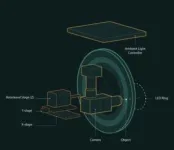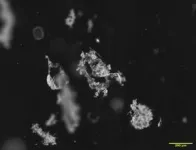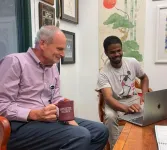(Press-News.org) New Stanford-led research unveils a hidden factor that could change our understanding of how oceans mitigate climate change. The study, published Oct. 11 in Science, reveals never-before seen mucus “parachutes” produced by microscopic marine organisms that significantly slow their sinking, putting the brakes on a process crucial for removing carbon dioxide from the atmosphere. The surprising discovery implies that previous estimates of the ocean’s carbon sequestration potential may have been overestimated, but also paves the way toward improving climate models and informing policymakers in their efforts to slow climate change.
“We haven’t been looking the right way,” said study senior author Manu Prakash, an associate professor of bioengineering and of oceans in the Stanford School of Engineering and Stanford Doerr School of Sustainability. “What we found underscores the importance of fundamental scientific observation and the need to study natural processes in their true environments. It’s critical to our ability to mitigate climate change.”
The biological pump
Marine snow – a mixture of dead phytoplankton, bacteria, fecal pellets, and other organic particles – absorbs about a third of human-made carbon dioxide from the atmosphere and shuttles it down to the ocean floor where it is locked away for millennia. Scientists have known about this phenomenon – known as the biological pump – for some time. However, the exact manner in which these delicate particles fall (the ocean’s average depth is 4 kilometers, or 2.5 miles) has remained a mystery until now.
The researchers unlocked the mystery using an unusual invention – a rotating microscope developed in Prakash’s lab that flips the problem on its head. The device moves as organisms move within it, simulating vertical travel over infinite distances and adjusting aspects such as temperature, light, and pressure to emulate specific ocean conditions.
Over the past five years, Prakash and his lab members have brought their custom-built microscopes on research vessels to all the world’s major oceans – from the Arctic to Antarctica. On a recent expedition to the Gulf of Maine, they collected marine snow by hanging traps in the water, then rapidly analyzed the particles’ sinking process in their rotating microscope. Since marine snow is a living ecosystem, it is important to make these measurements at sea. The rotating microscope allowed the team to observe marine snow in its natural environment in exquisite detail – instead of a distant lab – for the first time.
The results stunned the researchers. They revealed that marine snow sometimes creates parachute-like mucus structures that effectively double the time the organisms linger in the upper 100 meters of the ocean. This prolonged suspension increases the likelihood of other microbes breaking down the organic carbon within the marine snow particles and converting it back into readily available organic carbon for other plankton – stalling carbon dioxide absorption from the atmosphere.
Beauty and complexity in the smallest details
The researchers point to their work as an example of observation-driven research, essential to understanding how even the smallest biological and physical processes work within natural systems.
“Theory tells you how a flow around a small particle looks like, but what we saw on the boat was dramatically different,” said study lead author Rahul Chajwa, a postdoctoral scholar in the Prakash Lab. “We are at the beginning of understanding these complex dynamics.”
This work lays out an important fact. For the last 200 years, scientists have studied life, including plankton, in a two-dimensional plane, trapped in small cover slips under a microscope. On the other hand, doing microscopy at high resolution is very hard on the high seas. Chajwa and Prakash emphasize the importance of leaving the lab and conducting scientific measurements as close as possible to the environment in which they occur.
Supporting research that prioritizes observation in natural environments should be a priority for public and private organizations that fund science, the researchers argue.
“We cannot even ask the fundamental question of what life does without emulating the environment that it evolved with,” Prakash said. “In biology, stripping it away from its environment has stripped away any of our capacity to ask the right questions.”
Beyond its importance in directly measuring marine carbon sequestration, the study also reveals the beauty in everyday phenomena. Much like sugar dissolving in coffee, marine snow’s descent into the depth of the ocean is a complex process influenced by factors we don’t always see or appreciate.
“We take for granted certain phenomena, but the simplest set of ideas can have profound effects,” Prakash said. “Observing these details – like the mucus tails of marine snow – opens new doors to understanding the fundamental principles of our world.”
The researchers are working to refine their models, integrate the datasets into Earth-scale models, and release an open dataset from the six global expeditions they have conducted so far. This will be the world’s largest dataset of direct marine snow sedimentation measurements. They also aim to explore factors that influence mucus production, such as environmental stressors or the presence of certain species of bacteria.
Although the researchers’ discovery is a significant jolt to how scientists have thought about tipping points in ocean-based sequestration, Prakash and his colleagues remain hopeful. On a recent expedition off the coast of Northern California, they discovered processes that can potentially speed up carbon sequestration.
“Every time I observe the world of plankton via our tools, I learn something new,” Prakash said.
Prakash is an associate professor of bioengineering in the Stanford Schools of Engineering and Medicine; associate professor, by courtesy, of biology in the Stanford School of Humanities and Sciences; associate professor, by courtesy, of oceans in the Stanford Doerr School of Sustainability; senior fellow at the Stanford Woods Institute for the Environment; and member of Bio-X, the Maternal & Child Health Research Institute, and the Wu Tsai Neurosciences Institute.
Co-authors of the study also include Eliott Flaum, a PhD student in biophysics in the Stanford School of Medicine at the time of the research, and researchers from Rutgers University and the Woods Hole Oceanographic Institution.
This project was funded by the Big Ideas for Oceans program of the Stanford Doerr School of Sustainability’s Oceans Department and the Stanford Woods Institute for the Environment, the Schmidt Foundation Innovation Fellows Program, the National Science Foundation, the Human Frontier Science Program, and Dalio Philanthropies.
END
Hidden biological processes can affect how the ocean stores carbon
2024-10-10
ELSE PRESS RELEASES FROM THIS DATE:
European forest plants are migrating westwards, nitrogen main cause
2024-10-10
New research reveals nitrogen pollution, and to a lesser extent climate change, unexpectedly as the key driver behind surprising westward shifts in the distribution of plants.
A recent study has uncovered that many European forest plant species are moving towards the west due to high nitrogen deposition levels, defying the common belief that climate change is the primary cause of species moving northward. This finding reshapes our understanding of how environmental factors, and in particular nitrogen pollution, influence biodiversity.
While it is widely assumed that rising temperatures are pushing many species toward cooler, northern areas, this research shows that westward ...
Macronutrient and micronutrient intake among US women ages 20 to 44
2024-10-10
About The Study: This cross-sectional study of pregnant and nonpregnant women of reproductive age found that vitamin A, vitamin C, and iron intake decreased over the past 2 decades, which may have substantial maternal and fetal health implications. By identifying these nutrient gaps and trends in inadequate intake in this at-risk population, scientific, health care, and regulatory communities may be better poised to adopt recommendations to improve nutrient intake.
Corresponding Author: To contact the corresponding author, Derek Miketinas, PhD, RD, email dmiketinas@twu.edu.
To access the embargoed study: Visit our For The Media website ...
Payments by drug and medical device manufacturers to us peer reviewers of major medical journals
2024-10-10
About The Study: More than half of the 1,962 U.S. physicians included in this study who peer reviewed for the most influential medical journals received industry payments in 2020-2022, with most payments for research. Research payments, especially those provided to an institution, may have different implications than general payments for conflicts of interest.
Corresponding Author: To contact the corresponding author, Christopher J. D. Wallis, MD, PhD, email wallis.cjd@gmail.com.
To access the embargoed study: Visit our For The Media website at this link https://media.jamanetwork.com/
(doi:10.1001/jama.2024.17681)
Editor’s Note: Please see the article ...
One-third of cancer-related crowdfunding campaigns share medical financial hardship and health-related social needs, new research shows
2024-10-10
In a new, large comprehensive analysis led by the American Cancer Society (ACS), researchers, using a form of Artificial Intelligence (AI), found that more than one-third of fundraising stories on the GoFundMe crowdfunding platform in the United States explicitly shared experiences of medical financial hardships and health-related social needs (HRSNs). The fundraising stories included hardships such as housing and food insecurities, transportation barriers, income loss, lack of sick leave, and disruptions to both work and school. The findings are published today ...
Faulty 'fight or flight' response drives deadly C. difficile infections, research reveals
2024-10-10
The portion of our nervous systems responsible for the “fight or flight” response can shape the severity of potentially deadly C. difficile infections, new research from the University of Virginia School of Medicine reveals.
The findings suggest that doctors may be able to save patients from the infections – a plague for hospitals and nursing homes – by using drugs to quiet the hyperactive nervous system response, the researchers say.
“Compared to how much we know about immune system influences in C. difficile infections, the field is just scratching ...
Checking out the boundaries: Milestone in lipidomics achieved
2024-10-10
Results of the first phase of a Ceramide Ring Trial have just been published in the renowned journal Nature Communications, representing a significant landmark in the field of lipidomics. This achievement, involving researchers at the University of Vienna and scientific teams in Singapore, Julich and Espoo, represents a groundbreaking advance in the establishment of ceramide reference values, plasma lipids involved in such as cardiovascular diseases. The ring trial was performed under the umbrella of the International Lipidomics Society ...
SNU-KAIST researchers jointly develop a new visible light communication encryption technology using chiral nanoparticles
2024-10-10
Seoul National University(SNU) College of Engineering announced that a joint research team led by Professor Ki Tae Nam from the Department of Materials Science and Engineering at SNU and Professor Junil Choi from the Korea Advanced Institute of Science and Technology (KAIST) has developed a novel visible light communication encryption technology with high security using chiral nanoparticles.
Just as a lighthouse provides a guiding beam in the vast darkness of the sea, light-based information transmission has been a crucial means of communication throughout human history. ...
HPTN 091 study shows encouraging uptake and adherence to oral PrEP among transgender women
2024-10-10
DURHAM, N.C. – Researchers from the HIV Prevention Trials Network (HPTN) presented results from HPTN 091 (“I Am Study”) at the HIVR4P 2024 conference in Lima, Peru. The study examined the acceptability and feasibility of an integrated multicomponent strategy to enhance daily oral HIV pre-exposure prophylaxis (PrEP) uptake and adherence among transgender women in a randomized immediate versus deferred design. The integrated care strategy included the provision of gender-affirming hormone ...
Gonzalez receives award to study causes of racial disparities in amputation rates in Indiana
2024-10-10
INDIANAPOLIS --More than 8 million people, ages 40 and older, living in the U.S. are affected by peripheral arterial disease, a lifelong medical condition and the most common cause of limb amputation in the country. A data scientist, health services researcher and vascular surgeon who studies health equity, Andrew A. Gonzalez, M.D., J.D., MPH, of the Regenstrief Institute and the Indiana University School of Medicine, has received a 2024 Ralph W. and Grace M. Showalter Research Trust award to conduct a new study, Exploring Causes of Racial Disparities in Amputation Rates in Indiana.
Dr. ...
Mount Sinai opens state-of-the-art center for patients with complex conditions including Lyme disease and long COVID
2024-10-10
Mount Sinai’s Department of Rehabilitation and Human Performance has announced the grand opening of the Cohen Center for Recovery From Complex Chronic Illnesses (CoRE), providing clinical care for patients with conditions such as long Lyme disease/Lyme+, long COVID, and other infection-associated complex chronic illnesses such as myalgic encephalomyelitis/chronic fatigue syndrome (ME/CFS) and Ehlers-Danlos syndrome (EDS).
Supported by philanthropy from various donors, including an inaugural gift from Beth and ...








